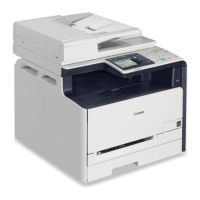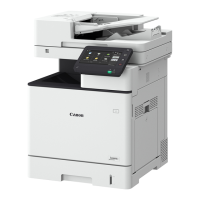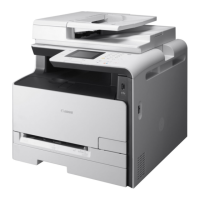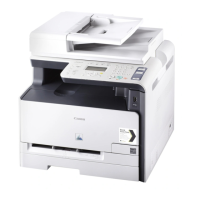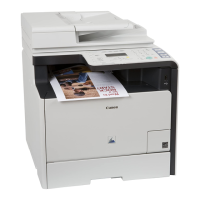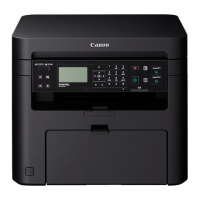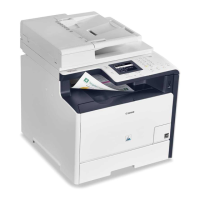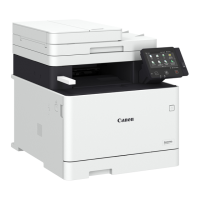Do you have a question about the Canon MF8230Cn and is the answer not in the manual?
Specifies the necessary conditions for installing the machine in a suitable location.
Details the acceptable temperature and humidity ranges for machine installation.
Provides instructions for cleaning the exterior, rollers, fixing unit, transfer belt, and platen glass.
Explains how to check toner levels and replace toner cartridges when they are low or empty.
Detailed step-by-step instructions for replacing toner cartridges.
Information on average toner yields and when to replace cartridges.
Guidance on safely moving the machine to a new location, including precautions.
Procedures for adjusting print quality, including gradation, color mismatch, and text processing.
Instructions for printing various reports like TX Result, Communication Management, and Address Book.
Restores machine settings to factory defaults for various categories like Network and System Management.
Guidelines for storing toner cartridges to ensure quality and prevent damage.
Advisory regarding the use and performance issues of counterfeit toner cartridges.
Lists and describes the items included with the machine.
Step-by-step instructions for removing all protective materials before installation.
Instructions for removing sealing tape from installed toner cartridges before use.
Guides on how to load paper into the paper drawer and manual feed slot.
Procedure for installing the optional handset for specific models.
Instructions for connecting the power cord to the machine and power outlet.
Steps for powering on the machine and configuring initial settings like language and time zone.
Explains how to connect the machine to a computer via wireless LAN, wired LAN, or USB.
Steps to configure basic fax settings, including receive mode and telephone line connection.
Instructions for connecting the machine to a computer using a wireless LAN connection.
Instructions for connecting the machine to a computer using a wired LAN connection.
Instructions for connecting the machine to a computer using a USB cable.
Guides the user to select the appropriate fax receive mode based on intended use.
Procedure to register the machine's fax number and unit name for outgoing faxes.
Steps to select the receive mode that suits the intended fax usage.
Instructions for connecting the telephone line to the machine for fax functionality.
Describes the exterior, interior, and operation panel parts of the machine.
Procedure for logging on when Department ID Management is enabled.
Instructions on how to place documents on the platen glass or in the feeder for scanning.
Guides on how to load paper into the paper drawer and manual feed slot.
Explains how to use the keys on the operation panel for settings and operations.
How to register destinations for faxes or scanned documents in the Address Book.
How to adjust the volume of machine sounds like fax transmission completion or error alerts.
Instructions on how to set the machine's sleep mode for power saving.
Covers fundamental steps for performing copy operations.
Procedure to cancel copying operations immediately or after checking status.
How to specify the paper source for printing copies.
Details various copy settings like enlarging, density, duplex, and collation.
Guidance on setting default copy options or registering frequently used combinations.
Covers fundamental steps for sending faxes, including document placement and destination entry.
Details settings for scan quality like resolution, density, and sharpness for fax transmission.
Methods to specify fax destinations using numeric keys, Address Book, or LDAP server.
Describes various fax methods like manual sending, sequential broadcast, and memory reception.
Instructions for sending fax documents directly from a computer application.
Ensures the machine and computer are connected and software is installed for scanning.
How to scan documents using the operation panel and save them to a computer or USB.
Instructions for scanning documents placed on the machine from a computer.
Utilizing the bundled MF Toolbox application for scanning and image management.
Basic scan settings for easy operation via ScanGear MF's Simple Mode.
Advanced scan adjustments for image quality, resolution, and color settings.
Scan documents directly to a USB memory device without using a computer.
Convert scanned documents to PDF and send them as e-mail attachments directly from the machine.
Convert scanned documents to PDF, TIFF, or JPEG and store them in shared folders on computers.
Allows users to specify the scanning size of documents.
Enables selection of file formats like PDF, TIFF, or JPEG for scanned documents.
Allows adjustment of scan density for text or images that are too light or dark.
Allows specification of portrait or landscape orientation for scanned documents.
Helps select the image quality for scans based on document type (text, photo, graphics).
Instructions for automatically scanning the front and back sides of documents in the feeder.
Allows adjustment of image sharpness for scanned documents.
Balances file size and image quality by specifying compression ratio.
Specifies gamma values to apply to scanned documents for accurate brightness display.
Guides on connecting the machine to a wired or wireless LAN.
Allows selection between wired or wireless LAN connection via operation panel.
Instructions for connecting the machine to a computer via a router using a LAN cable.
Steps for connecting the machine to a computer using wireless LAN.
Manually set up wireless connection by selecting an available wireless router.
Manually enter required information for wireless LAN connection, including security settings.
How to check the SSID and network key of a wireless router from a computer.
Configures unique network IP addresses (IPv4/IPv6) for the machine.
Configures protocols and ports for network printing/faxing and creating a print server.
Sets up printing protocols like LPD, RAW, and WSD functions for networked computers.
Configures printer port settings on the computer to resolve printing errors.
Sets up the machine as a print server to reduce computer load and simplify driver installation.
Setup for sending scanned documents via e-mail or saving to shared folders directly from the machine.
Guidance on configuring the machine to suit various network environments.
Sets communication mode (half/full duplex) and Ethernet type (10/100 Mbps).
Specifies settings for Domain Name System (DNS) for host name resolution.
Configures settings for Server Message Block (SMB) protocol for shared folder access.
Configures Windows Internet Name Service (WINS) for NetBIOS name resolution.
Registers LDAP servers for searching fax numbers or e-mail addresses.
Adjusts the system clock using time server synchronization (SNTP).
Uses SNMP to monitor and control network devices.
Facilitates device management by using Service Location Protocol (SLP) for information gathering.
General principles for securing information devices against threats.
Measures to prevent unauthorized access, including user privileges and firewalls.
Considerations for mitigating risks from improper use or negligence.
Limits machine capabilities by disabling functions partially or completely.
Limits access to Address Book and sending functions for enhanced security.
Requires a PIN to add or edit Address Book entries, reducing unauthorized changes.
Restricts destinations for fax/email to registered entries or LDAP servers.
Disables the PC fax function to prevent unauthorized faxing from computers.
Prevents selection of previously used destinations from transmission records.
Reduces faxing errors by requiring double entry of fax numbers or coded dial details.
Disables sequential broadcasting feature to prevent sending faxes to multiple recipients.
Limits use of USB ports for connecting devices or storing data.
Disables HTTP to block unauthorized access via the unused HTTP port.
Reduces remote access risk by disabling Remote UI when not needed.
Details advanced security features like SSL, IPSec, and 802.1X authentication.
Encrypts communication between machine and browser for secure remote access.
Sets up IPSec for encrypting IP packets for secure network communication.
Configures network access control using IEEE 802.1X authentication.
Manages key pairs and digital certificates for secure communication.
Procedure to generate a key pair for SSL encrypted communication.
Stores and registers key pairs and digital certificates obtained from a CA.
Views detailed information and verifies the validity and signature of registered certificates.
Overview of the Remote UI's capabilities for machine management and settings.
Lists the required environment for using the Remote UI, including Web browser and OS.
Steps to access the machine's interface using a Web browser.
Describes the layout and elements of the Remote UI interface.
How to check print status, history, errors, device specs, and system manager info.
Guides on changing various machine settings via the Remote UI.
Procedures for saving and loading machine settings and Address Book data.
Save or load Address Book data to/from a computer using the Remote UI.
Save or load machine settings (menu options) to/from a computer.
Register or edit the machine's Address Book using a computer via the Remote UI.
Lists all settings related to network configuration.
Settings related to sound volume and display options.
Configuration options for machine timers like Auto Reset and Sleep Mode.
Settings related to paper drawer selection and paper feed method.
Configuration options for copy functions like number of copies, density, and paper type.
Configuration options for fax functions like line type, ECM, and redial settings.
Configuration options for scan functions like file format, resolution, and density.
Settings for printing from USB memory devices or memory cards.
Configuration options for printer functions like copies, paper, quality, and layout.
Procedures for cleaning the machine and adjusting print quality.
Administrative settings for security, network, and system configuration.
Restores machine settings to factory defaults for various categories.
Guidance on clearing paper jams from various locations within the machine.
Lists and explains common error messages displayed on the machine.
Troubleshooting common issues like power, connectivity, sleep mode, and messages.
Resolves issues related to software installation and incorrect settings.
Troubleshooting common issues encountered during copying operations.
Addresses common issues affecting printing quality and speed.
Troubleshooting issues related to fax transmission and telephone line connectivity.
Solutions for print quality issues like smudges, streaks, and paper handling problems.
Addresses issues like smudges, streaks, faded printouts, and poor density.
Solutions for paper creasing or curling problems.
Troubleshooting for skewed paper or multiple sheets fed together.
Guidance on contacting Canon support for unresolved issues.
Routine cleaning procedures for machine parts like exterior, feeder, and platen glass.
Information on when and how to replace toner cartridges.
Detailed step-by-step instructions for replacing toner cartridges.
Provides details on toner cartridge yields and recommendations.
Safety precautions and procedures for moving the machine to a new location.
Adjustments to enhance print quality, including gradation and color settings.
Instructions for printing various reports like TX Result, Communication Management, and Address Book.
How to view the total page count for copies, prints, faxes, and scans.
Restores machine settings to factory defaults for various categories.
Highlights key features and benefits of the machine.
Features that promote energy saving and cost reduction, like 2-sided printing and sleep mode.
Features that enhance productivity, such as Address Book and shortcut keys.
Features that facilitate digital document workflows like Scan to E-mail and Scan to Shared Folder.
Highlights additional features like Google Cloud Print, Secure Print, and Wireless connectivity.
Technical details of the machine's capabilities and components.
Detailed specifications for the machine's hardware and performance.
Specifications for the optional paper drawer unit.
Technical details for the wireless LAN module.
Information on supported document types for scanning.
Details the scan area for platen glass and feeder depending on the function.
Lists supported paper sizes and handling information.
Technical details of the copy function's performance.
Technical details of the fax function's performance.
Technical details of the scanner function's performance.
Technical details of the printer function's performance.
Technical details for scanning and sending documents via e-mail.
Technical details for scanning documents to shared folders.
Guidance on how to access and navigate the electronic manual.
Instructions for installing the e-Manual on your computer from the CD-ROM.
Procedure to remove the e-Manual from the computer.
Description of the elements and layout of the e-Manual screens.
Instructions on how to view the e-Manual on your computer.
Lists abbreviations for product names and operating systems used in the manual.
Contains basic Windows operations, disclaimers, copyright, and other information.
Instructions for basic Windows operations like using Explorer and Control Panel.
How to check if your computer is running a 32-bit or 64-bit operating system.
How to check the port settings for LPR/RAW printer ports.
Contains regulatory information, safety notices, and disclaimers.
Provides contact information for Canon offices worldwide.
Prerequisites and introductory information before installing MF drivers.
Details the MF drivers, utilities, and additional software included.
Lists the operating systems compatible with the included software.
Guides on selecting the appropriate driver based on connection method.
Step-by-step guide for installing MF drivers and MF Toolbox.
Procedure for installing MF drivers and software using the easy installation method.
Procedure for installing MF drivers and software using custom installation.
Instructions for installing software on Macintosh computers.
Steps for connecting the machine to a computer via USB cable.
How to verify that MF drivers, MF Toolbox, and e-Manual are installed correctly.
Procedure to register the machine in Macintosh for printing and faxing.
Instructions for installing drivers/software downloaded from the Canon website.
Specifies the necessary conditions for installing the machine in a suitable location.
Details the acceptable temperature and humidity ranges for machine installation.
Provides instructions for cleaning the exterior, rollers, fixing unit, transfer belt, and platen glass.
Explains how to check toner levels and replace toner cartridges when they are low or empty.
Detailed step-by-step instructions for replacing toner cartridges.
Information on average toner yields and when to replace cartridges.
Guidance on safely moving the machine to a new location, including precautions.
Procedures for adjusting print quality, including gradation, color mismatch, and text processing.
Instructions for printing various reports like TX Result, Communication Management, and Address Book.
Restores machine settings to factory defaults for various categories like Network and System Management.
Guidelines for storing toner cartridges to ensure quality and prevent damage.
Advisory regarding the use and performance issues of counterfeit toner cartridges.
Lists and describes the items included with the machine.
Step-by-step instructions for removing all protective materials before installation.
Instructions for removing sealing tape from installed toner cartridges before use.
Guides on how to load paper into the paper drawer and manual feed slot.
Procedure for installing the optional handset for specific models.
Instructions for connecting the power cord to the machine and power outlet.
Steps for powering on the machine and configuring initial settings like language and time zone.
Explains how to connect the machine to a computer via wireless LAN, wired LAN, or USB.
Steps to configure basic fax settings, including receive mode and telephone line connection.
Instructions for connecting the machine to a computer using a wireless LAN connection.
Instructions for connecting the machine to a computer using a wired LAN connection.
Instructions for connecting the machine to a computer using a USB cable.
Guides the user to select the appropriate fax receive mode based on intended use.
Procedure to register the machine's fax number and unit name for outgoing faxes.
Steps to select the receive mode that suits the intended fax usage.
Instructions for connecting the telephone line to the machine for fax functionality.
Describes the exterior, interior, and operation panel parts of the machine.
Procedure for logging on when Department ID Management is enabled.
Instructions on how to place documents on the platen glass or in the feeder for scanning.
Guides on how to load paper into the paper drawer and manual feed slot.
Explains how to use the keys on the operation panel for settings and operations.
How to register destinations for faxes or scanned documents in the Address Book.
How to adjust the volume of machine sounds like fax transmission completion or error alerts.
Instructions on how to set the machine's sleep mode for power saving.
Covers fundamental steps for performing copy operations.
Procedure to cancel copying operations immediately or after checking status.
How to specify the paper source for printing copies.
Details various copy settings like enlarging, density, duplex, and collation.
Guidance on setting default copy options or registering frequently used combinations.
Covers fundamental steps for sending faxes, including document placement and destination entry.
Details settings for scan quality like resolution, density, and sharpness for fax transmission.
Methods to specify fax destinations using numeric keys, Address Book, or LDAP server.
Describes various fax methods like manual sending, sequential broadcast, and memory reception.
Instructions for sending fax documents directly from a computer application.
Ensures the machine and computer are connected and software is installed for scanning.
How to scan documents using the operation panel and save them to a computer or USB.
Instructions for scanning documents placed on the machine from a computer.
Utilizing the bundled MF Toolbox application for scanning and image management.
Basic scan settings for easy operation via ScanGear MF's Simple Mode.
Advanced scan adjustments for image quality, resolution, and color settings.
Scan documents directly to a USB memory device without using a computer.
Convert scanned documents to PDF and send them as e-mail attachments directly from the machine.
Convert scanned documents to PDF, TIFF, or JPEG and store them in shared folders on computers.
Allows users to specify the scanning size of documents.
Enables selection of file formats like PDF, TIFF, or JPEG for scanned documents.
Allows adjustment of scan density for text or images that are too light or dark.
Allows specification of portrait or landscape orientation for scanned documents.
Helps select the image quality for scans based on document type (text, photo, graphics).
Instructions for automatically scanning the front and back sides of documents in the feeder.
Allows adjustment of image sharpness for scanned documents.
Balances file size and image quality by specifying compression ratio.
Specifies gamma values to apply to scanned documents for accurate brightness display.
Guides on connecting the machine to a wired or wireless LAN.
Allows selection between wired or wireless LAN connection via operation panel.
Instructions for connecting the machine to a computer via a router using a LAN cable.
Steps for connecting the machine to a computer using wireless LAN.
Manually set up wireless connection by selecting an available wireless router.
Manually enter required information for wireless LAN connection, including security settings.
How to check the SSID and network key of a wireless router from a computer.
Configures unique network IP addresses (IPv4/IPv6) for the machine.
Configures protocols and ports for network printing/faxing and creating a print server.
Sets up printing protocols like LPD, RAW, and WSD functions for networked computers.
Configures printer port settings on the computer to resolve printing errors.
Sets up the machine as a print server to reduce computer load and simplify driver installation.
Setup for sending scanned documents via e-mail or saving to shared folders directly from the machine.
Guidance on configuring the machine to suit various network environments.
Sets communication mode (half/full duplex) and Ethernet type (10/100 Mbps).
Specifies settings for Domain Name System (DNS) for host name resolution.
Configures settings for Server Message Block (SMB) protocol for shared folder access.
Configures Windows Internet Name Service (WINS) for NetBIOS name resolution.
Registers LDAP servers for searching fax numbers or e-mail addresses.
Adjusts the system clock using time server synchronization (SNTP).
Uses SNMP to monitor and control network devices.
Facilitates device management by using Service Location Protocol (SLP) for information gathering.
General principles for securing information devices against threats.
Measures to prevent unauthorized access, including user privileges and firewalls.
Considerations for mitigating risks from improper use or negligence.
Limits machine capabilities by disabling functions partially or completely.
Limits access to Address Book and sending functions for enhanced security.
Requires a PIN to add or edit Address Book entries, reducing unauthorized changes.
Restricts destinations for fax/email to registered entries or LDAP servers.
Disables the PC fax function to prevent unauthorized faxing from computers.
Prevents selection of previously used destinations from transmission records.
Reduces faxing errors by requiring double entry of fax numbers or coded dial details.
Disables sequential broadcasting feature to prevent sending faxes to multiple recipients.
Limits use of USB ports for connecting devices or storing data.
Disables HTTP to block unauthorized access via the unused HTTP port.
Reduces remote access risk by disabling Remote UI when not needed.
Details advanced security features like SSL, IPSec, and 802.1X authentication.
Encrypts communication between machine and browser for secure remote access.
Sets up IPSec for encrypting IP packets for secure network communication.
Configures network access control using IEEE 802.1X authentication.
Manages key pairs and digital certificates for secure communication.
Procedure to generate a key pair for SSL encrypted communication.
Stores and registers key pairs and digital certificates obtained from a CA.
Views detailed information and verifies the validity and signature of registered certificates.
Overview of the Remote UI's capabilities for machine management and settings.
Lists the required environment for using the Remote UI, including Web browser and OS.
Steps to access the machine's interface using a Web browser.
Describes the layout and elements of the Remote UI interface.
How to check print status, history, errors, device specs, and system manager info.
Guides on changing various machine settings via the Remote UI.
Procedures for saving and loading machine settings and Address Book data.
Save or load Address Book data to/from a computer using the Remote UI.
Save or load machine settings (menu options) to/from a computer.
Register or edit the machine's Address Book using a computer via the Remote UI.
Lists all settings related to network configuration.
Settings related to sound volume and display options.
Configuration options for machine timers like Auto Reset and Sleep Mode.
Settings related to paper drawer selection and paper feed method.
Configuration options for copy functions like number of copies, density, and paper type.
Configuration options for fax functions like line type, ECM, and redial settings.
Configuration options for scan functions like file format, resolution, and density.
Settings for printing from USB memory devices or memory cards.
Configuration options for printer functions like copies, paper, quality, and layout.
Procedures for cleaning the machine and adjusting print quality.
Administrative settings for security, network, and system configuration.
Restores machine settings to factory defaults for various categories.
Guidance on clearing paper jams from various locations within the machine.
Lists and explains common error messages displayed on the machine.
Troubleshooting common issues like power, connectivity, sleep mode, and messages.
Resolves issues related to software installation and incorrect settings.
Troubleshooting common issues encountered during copying operations.
Addresses common issues affecting printing quality and speed.
Troubleshooting issues related to fax transmission and telephone line connectivity.
Solutions for print quality issues like smudges, streaks, and paper handling problems.
Addresses issues like smudges, streaks, faded printouts, and poor density.
Solutions for paper creasing or curling problems.
Troubleshooting for skewed paper or multiple sheets fed together.
Guidance on contacting Canon support for unresolved issues.
Routine cleaning procedures for machine parts like exterior, feeder, and platen glass.
Information on when and how to replace toner cartridges.
Detailed step-by-step instructions for replacing toner cartridges.
Provides details on toner cartridge yields and recommendations.
Safety precautions and procedures for moving the machine to a new location.
Adjustments to enhance print quality, including gradation and color settings.
Instructions for printing various reports like TX Result, Communication Management, and Address Book.
How to view the total page count for copies, prints, faxes, and scans.
Restores machine settings to factory defaults for various categories.
Highlights key features and benefits of the machine.
Features that promote energy saving and cost reduction, like 2-sided printing and sleep mode.
Features that enhance productivity, such as Address Book and shortcut keys.
Features that facilitate digital document workflows like Scan to E-mail and Scan to Shared Folder.
Highlights additional features like Google Cloud Print, Secure Print, and Wireless connectivity.
Technical details of the machine's capabilities and components.
Detailed specifications for the machine's hardware and performance.
Specifications for the optional paper drawer unit.
Technical details for the wireless LAN module.
Information on supported document types for scanning.
Details the scan area for platen glass and feeder depending on the function.
Lists supported paper sizes and handling information.
Technical details of the copy function's performance.
Technical details of the fax function's performance.
Technical details of the scanner function's performance.
Technical details of the printer function's performance.
Technical details for scanning and sending documents via e-mail.
Technical details for scanning documents to shared folders.
Guidance on how to access and navigate the electronic manual.
Instructions for installing the e-Manual on your computer from the CD-ROM.
Procedure to remove the e-Manual from the computer.
Description of the elements and layout of the e-Manual screens.
Instructions on how to view the e-Manual on your computer.
Lists abbreviations for product names and operating systems used in the manual.
Contains basic Windows operations, disclaimers, copyright, and other information.
Instructions for basic Windows operations like using Explorer and Control Panel.
How to check if your computer is running a 32-bit or 64-bit operating system.
How to check the port settings for LPR/RAW printer ports.
Contains regulatory information, safety notices, and disclaimers.
Provides contact information for Canon offices worldwide.
Prerequisites and introductory information before installing MF drivers.
Details the MF drivers, utilities, and additional software included.
Lists the operating systems compatible with the included software.
Guides on selecting the appropriate driver based on connection method.
Step-by-step guide for installing MF drivers and MF Toolbox.
Procedure for installing MF drivers and software using the easy installation method.
Procedure for installing MF drivers and software using custom installation.
Instructions for installing software on Macintosh computers.
Steps for connecting the machine to a computer via USB cable.
How to verify that MF drivers, MF Toolbox, and e-Manual are installed correctly.
Procedure to register the machine in Macintosh for printing and faxing.
Instructions for installing drivers/software downloaded from the Canon website.
| Print Technology | Laser |
|---|---|
| Device Type | Multifunction printer |
| Paper Capacity | 250 sheets |
| Duplex Printing | Yes |
| Display | Color LCD |
| Max Copying Resolution | 600 x 600 dpi |
| Grayscale Half-Tones | 256 levels |
| Optical Resolution | 600 x 600 dpi |
| Weight | 26 kg |
| Operating Systems Supported | Windows, Mac OS |
| Functions | Print, Copy, Scan |
| Print Resolution | 1200 x 1200 dpi |
| Connectivity | USB 2.0, Ethernet |
| Display Size | 3.5" |
| Dimensions | 430 mm x 484 mm x 429 mm |
| Monthly Duty Cycle | 30, 000 pages |
| Fax Transmission Speed | Not applicable |

